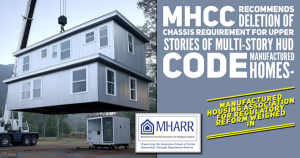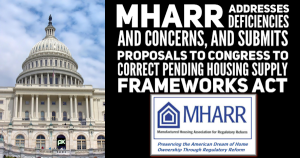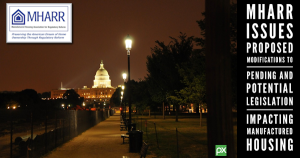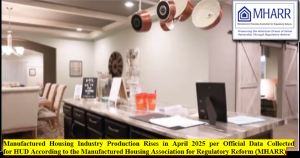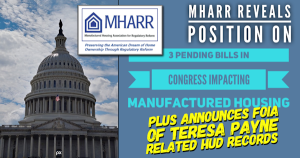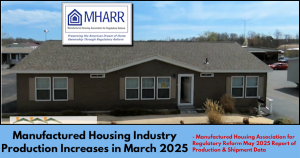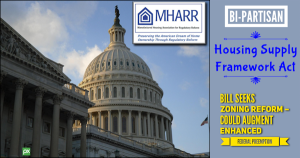“FREDDIE MAC UNWITTINGLY PROVES ITS OWN FAILURE” MHARR — ISSUES AND PERSPECTIVES — May 2021
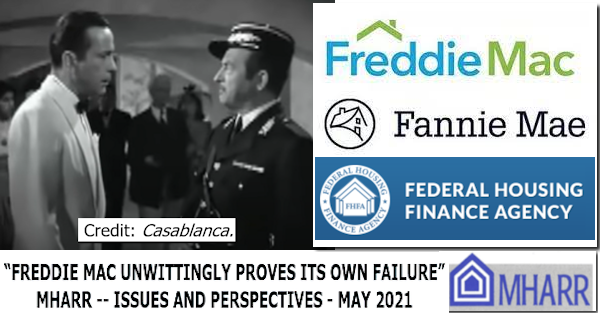
By Mark Weiss
MAY 2021
“FREDDIE MAC UNWITTINGLY PROVES ITS OWN FAILURE”
Remember Inspector Renault in the classic film “Casablanca,” who was “shocked, shocked” to find gambling going on at Rick’s? Well, we now have something similar with mortgage giant Freddie Mac. After doing virtually nothing — along with its cohort Fannie Mae — for a decade-plus to implement the Duty to Serve Underserved Markets (DTS) mandate with respect to the vast bulk of the mainstream HUD Code manufactured housing consumer finance market, Freddie Mac, in a recent analysis, is “shocked, shocked” to find, of all things, a significant and growing gap between the demand for – and the supply of – affordable “entry-level,” starter housing. But while it diagnoses the problem, it fails to draw the obvious connection between its own anti-DTS policies and the exponential growth of that supply/demand gap, which Freddie Mac warns, threatens the “wealth, health and stability of American communities.”
The analysis, by Freddie Mac Vice President and Chief Economist, Sam Khater, titled “The Significant Shortage of Starter Homes,” was published on April 15, 2021. It makes a number of significant points and observations regarding the American housing market in general, and the market for affordable “starter” homes in particular. Most relevant, though, to DTS, the manufactured housing market and Fannie and Freddie’s joint failure to implement DTS thus far in anything approaching a market-significant manner, is the fact that, as of the end of 2020, the supply of “entry-level” single-family homes in the United States stands some four million units below existing demand. According to other housing experts, such as Edward Pinto and Tobias Peter at the American Enterprise Institute, that gap is actually even larger – something in the neighborhood of eight million units or double the Freddie Mac estimate. But for our purposes, let’s assume that Freddie Mac’s number — which is bad enough — is correct. What does this mean for homeownership in America and for affordable, non-subsidized manufactured homeownership in particular, and what can be done to alleviate what Freddie Mac characterizes as “the significant and rapidly widening gap between entry-level supply and [entry-level] demand?”
Ultimately, Freddie Mac’s analysis concludes that the “main driver” of the entry-level housing supply/demand gap, is a “long-term decline in the … supply of entry-level single-family homes, or ‘starter homes.’” (Emphasis added). The analysis thus notes that in the 1970s, “the construction of new, entry-level homes averaged 418,000 units per year.” During the 1980s, however, that figure fell to an average of 314,000 units per year. The trend of reduced supply continued through the 1990s, with an average of 207,000 entry-level units, and in the 2000s, with an average of 150,000 units per year. Subsequently, during the 2010s, average entry-level housing supply according to Freddie Mac, declined even further, to an average of 55,000 units per year. “In the span of five decades,” then, the report concludes, “entry-level home construction fell from 418,000 units per year in the late 1970s to 65,000 in 2020.”
The gap between housing supply and housing demand at the “entry level,” consequently, is a long-term phenomenon that has been growing steadily, for decades. As the analysis emphasizes, “very simply, renters can’t buy houses that don’t exist.” Even worse, the analysis predicts that the gap between supply and demand will continue, stating: “[W]e expect the housing supply shortage to continue to be one of the largest obstacles to inclusive economic growth in the [United States]. Simply put, we must build more single-family entry-level housing to address this shortage, which has strong implications for the wealth, health and stability of American communities.” (Emphasis added).
Well, what a shock — a chronic shortfall in the availability of affordable, entry-level, starter homes. How could that happen? And who could have seen that coming? And what a comfort it is to know that Freddie Mac – which along with its sister enterprise, Fannie Mae – after decades of hypocrisy, discrimination and ongoing failure, has at long last “diagnosed” the obvious. But why is there a “starter housing” shortfall and, more importantly, what – if anything — are Freddie and Fannie doing about it?
The “why” part of the question is easy. There is a shortage of “entry-level,” “starter” homes at least in part because Fannie and Freddie have not provided the necessary level of consumer financing support for that segment of the market – a point that MHARR and others have been making for years. It’s a form of prejudice and bias – a willful “blind spot.” It’s why Fannie and Freddie almost collapsed in 2008 and ultimately had to be bailed-out by American taxpayers. Instead of providing much-needed financing support for lower-cost “starter” homes (such as manufactured homes) that would be affordable for qualified but lower and moderate-income buyers, Fannie and Freddie, for years, catered instead to more well-heeled purchasers, pushing them toward ever-more costly homes that they were barely qualified to finance. When the economic crisis hit in 2007/2008 and interest rates on subprime, adjustable and other “gimmick” loans shot up beyond what the borrowers could afford, the flood of resulting defaults almost sank the good ship Fannie/Freddie. Neither Freddie nor Fannie, however, could be troubled during that period with providing securitization or secondary market support for truly affordable mainstream, non-subsidized manufactured homes.
Congress, fortunately, had no such blind spot. When the credit crisis hit, Congress knew what the problem was, and what to do about Fannie and Freddie shoehorning unqualified or barely qualified borrowers into high-cost homes through gimmick loan products, instead of serving the lower and moderate-income Americans prioritized by their respective charters. With the support of all relevant stakeholders, Congress — through the DTS directive of the Housing and Economic Recovery Act of 2008 (HERA) — instructed Fannie and Freddie to actually begin serving fully-qualified but less affluent homebuyers seeking to purchase truly affordable homes within the manufactured housing market (and others). And, not to put too fine a point on it, this was not just a random request or polite invitation by Congress. Rather, it was an affirmative, mandatory command to finally begin serving the affordable, mainstream manufactured housing market in market-significant numbers.
Through DTS, Congress effectively recognized and diagnosed – nearly 15 years ago — the condition that Freddie and presumably Fannie are only now “shocked” to find. Congress, quite simply, recognized that the Enterprises were not serving the affordable, entry-level segment of the housing market, and directed them to do so, specifically by mandating, among other things, market-significant levels of support for inherently affordable, non-subsidized, mainstream manufactured housing. Full compliance with – and implementation of — DTS, accordingly, on a market-significant basis, would likely have already stopped and reversed the expanding gap between affordable, entry-level housing supply and demand as diagnosed and exposed by Freddie Mac in its April 2021 analysis.
But, of course, more than a decade later, Freddie Mac and Fannie Mae instead of affirmatively serving the mainstream HUD Code market under DTS, are seemingly doing their utmost to evade and avoid their DTS obligations altogether. Some 13 years after the enactment of DTS, then, as MHARR has frequently emphasized, Fannie and Freddie still do not provide any support for the personal property (chattel) loans that constitute nearly 80% of the consumer financing for mainstream HUD Code manufactured homes and have provided support for only a minisculeportion of the manufactured housing real estate market, amounting to no more than 5-6% of the total HUD Code market as previously calculated by MHARR. Effectively, then, Fannie and Freddie are – and have been – subverting Congress’ prescribed remedy for the very phenomenon they now claim to suddenly discern. As a result, it’s not surprising – and should not be surprising – that the affordable housing gap that DTS was designed to remedy still exists and, as “discovered” by Freddie Mac, is still growing.
Meanwhile, rather than providing consumer financing support for affordable, mainstream manufactured homes as directed by Congress, Fannie and Freddie are instead trying to divert DTS support to significantly more costly MH Advantage, ChoiceHome and so-called “Cross-Mod” homes, produced almost exclusively by the industry’s largest corporate conglomerates. Of course, in the real world, these MH Advantage, ChoiceHome and Cross-Mod offerings have generated virtually no originations at all (much the same as their early 2000s predecessor, the “MH Select” program). But what if they did? Those originations would not, by definition, increase the level of secondary market support or securitization for affordable, mainstream manufactured homes – which was and is the entire point of DTS. Consequently, as MHARR has also stressed, these programs are not so much an “effort” to implement DTS for the mainstream manufactured housing market, as they are an effort to sidestep DTS by fundamentally altering and distorting that market to fit the preexisting prejudices and biases of Fannie and Freddie.
Freddie Mac’s April 15, 2021 analysis, then, purports to diagnose a problem that Freddie and Fannie havethemselves helped to create – and perpetuate — through, among other things, their continuing failure to serve the affordable mainstream manufactured housing consumer financing market as mandated by DTS. Instead, then, of claiming to “discover” a condition (i.e., the long-term shortage of affordable “starter” housing) that is and should beobvious to anyone with a pulse, Freddie and Fannie should instead be “discovering” ways to solve that problem through the full, market-significant implementation of DTS – including manufactured housing personal property loans.
That being said, and in fairness to Fannie and Freddie, there are other contributing causes to the long-term decline in manufactured housing availability, including the Government National Mortgage Association’s (GNMA) noxious “10-10” rule, which has decimated the previously thriving Federal Housing Administration (FHA) Title I manufactured housing program, and exclusionary/discriminatory zoning, which has kept affordable, mainstream manufactured housing out of far too many communities across the United States, to the detriment of the very populations that the creators and enforcers of those provisions are sworn to represent and protect. But neither Fannie nor Freddie is in charge of – or responsible for – FHA/GNMA policy or discriminatory/exclusionary zoning. They are, however, responsible for their own implementation of DTS and whether or not mainstream, affordable manufactured housing consumers can get access to necessary consumer financing on the same, equitable basis as other homebuyers. And it is their failure to implement DTS for affordable, mainstream manufactured housing – over more than a decade – that, in substantial part, has allowed the destructive shortage of affordable, “entry-level” single-family starter housing to grow and fester.
Instead of publicly strutting, then, over diagnosing a problem that: (1) has previously been diagnosed by Congress; and (2) should be obvious to anyone connected to the housing market, Freddie and Fannie should instead be working to address and remedy that problem. And that, in turn, means fully and effectively implementing the DTS mandate within the manufactured housing sector, in a market-significant manner. Rather than bemoaning the supply/demand gap in the market for affordable, entry-level, starter housing, Fannie and Freddie should be looking in the mirror, at their own failure to implement the remedy that Congress has already prescribed for this significant and growing problem. Instead of more excuses, now is the time to fully implement DTS for the mainstream HUD Code manufactured housing market.
Mark Weiss
MHARR is a Washington, D.C.-based national trade association representing the views and interests of independent producers of federally-regulated manufactured housing.
“MHARR-Issues and Perspectives” is available for re-publication in full (i.e., without alteration or substantive modification) without further permission and with proper attribution to MHARR.
By Mark Weiss
MAY 2021
“FREDDIE MAC UNWITTINGLY PROVES ITS OWN FAILURE”
Remember Inspector Renault in the classic film “Casablanca,” who was “shocked, shocked” to find gambling going on at Rick’s? Well, we now have something similar with mortgage giant Freddie Mac. After doing virtually nothing — along with its cohort Fannie Mae — for a decade-plus to implement the Duty to Serve Underserved Markets (DTS) mandate with respect to the vast bulk of the mainstream HUD Code manufactured housing consumer finance market, Freddie Mac, in a recent analysis, is “shocked, shocked” to find, of all things, a significant and growing gap between the demand for – and the supply of – affordable “entry-level,” starter housing. But while it diagnoses the problem, it fails to draw the obvious connection between its own anti-DTS policies and the exponential growth of that supply/demand gap, which Freddie Mac warns, threatens the “wealth, health and stability of American communities.”
The analysis, by Freddie Mac Vice President and Chief Economist, Sam Khater, titled “The Significant Shortage of Starter Homes,” was published on April 15, 2021. It makes a number of significant points and observations regarding the American housing market in general, and the market for affordable “starter” homes in particular. Most relevant, though, to DTS, the manufactured housing market and Fannie and Freddie’s joint failure to implement DTS thus far in anything approaching a market-significant manner, is the fact that, as of the end of 2020, the supply of “entry-level” single-family homes in the United States stands some four million units below existing demand. According to other housing experts, such as Edward Pinto and Tobias Peter at the American Enterprise Institute, that gap is actually even larger – something in the neighborhood of eight million units or double the Freddie Mac estimate. But for our purposes, let’s assume that Freddie Mac’s number — which is bad enough — is correct. What does this mean for homeownership in America and for affordable, non-subsidized manufactured homeownership in particular, and what can be done to alleviate what Freddie Mac characterizes as “the significant and rapidly widening gap between entry-level supply and [entry-level] demand?”
Ultimately, Freddie Mac’s analysis concludes that the “main driver” of the entry-level housing supply/demand gap, is a “long-term decline in the … supply of entry-level single-family homes, or ‘starter homes.’” (Emphasis added). The analysis thus notes that in the 1970s, “the construction of new, entry-level homes averaged 418,000 units per year.” During the 1980s, however, that figure fell to an average of 314,000 units per year. The trend of reduced supply continued through the 1990s, with an average of 207,000 entry-level units, and in the 2000s, with an average of 150,000 units per year. Subsequently, during the 2010s, average entry-level housing supply according to Freddie Mac, declined even further, to an average of 55,000 units per year. “In the span of five decades,” then, the report concludes, “entry-level home construction fell from 418,000 units per year in the late 1970s to 65,000 in 2020.”
The gap between housing supply and housing demand at the “entry level,” consequently, is a long-term phenomenon that has been growing steadily, for decades. As the analysis emphasizes, “very simply, renters can’t buy houses that don’t exist.” Even worse, the analysis predicts that the gap between supply and demand will continue, stating: “[W]e expect the housing supply shortage to continue to be one of the largest obstacles to inclusive economic growth in the [United States]. Simply put, we must build more single-family entry-level housing to address this shortage, which has strong implications for the wealth, health and stability of American communities.” (Emphasis added).
Well, what a shock — a chronic shortfall in the availability of affordable, entry-level, starter homes. How could that happen? And who could have seen that coming? And what a comfort it is to know that Freddie Mac – which along with its sister enterprise, Fannie Mae – after decades of hypocrisy, discrimination and ongoing failure, has at long last “diagnosed” the obvious. But why is there a “starter housing” shortfall and, more importantly, what – if anything — are Freddie and Fannie doing about it?
The “why” part of the question is easy. There is a shortage of “entry-level,” “starter” homes at least in part because Fannie and Freddie have not provided the necessary level of consumer financing support for that segment of the market – a point that MHARR and others have been making for years. It’s a form of prejudice and bias – a willful “blind spot.” It’s why Fannie and Freddie almost collapsed in 2008 and ultimately had to be bailed-out by American taxpayers. Instead of providing much-needed financing support for lower-cost “starter” homes (such as manufactured homes) that would be affordable for qualified but lower and moderate-income buyers, Fannie and Freddie, for years, catered instead to more well-heeled purchasers, pushing them toward ever-more costly homes that they were barely qualified to finance. When the economic crisis hit in 2007/2008 and interest rates on subprime, adjustable and other “gimmick” loans shot up beyond what the borrowers could afford, the flood of resulting defaults almost sank the good ship Fannie/Freddie. Neither Freddie nor Fannie, however, could be troubled during that period with providing securitization or secondary market support for truly affordable mainstream, non-subsidized manufactured homes.
Congress, fortunately, had no such blind spot. When the credit crisis hit, Congress knew what the problem was, and what to do about Fannie and Freddie shoehorning unqualified or barely qualified borrowers into high-cost homes through gimmick loan products, instead of serving the lower and moderate-income Americans prioritized by their respective charters. With the support of all relevant stakeholders, Congress — through the DTS directive of the Housing and Economic Recovery Act of 2008 (HERA) — instructed Fannie and Freddie to actually begin serving fully-qualified but less affluent homebuyers seeking to purchase truly affordable homes within the manufactured housing market (and others). And, not to put too fine a point on it, this was not just a random request or polite invitation by Congress. Rather, it was an affirmative, mandatory command to finally begin serving the affordable, mainstream manufactured housing market in market-significant numbers.
Through DTS, Congress effectively recognized and diagnosed – nearly 15 years ago — the condition that Freddie and presumably Fannie are only now “shocked” to find. Congress, quite simply, recognized that the Enterprises were not serving the affordable, entry-level segment of the housing market, and directed them to do so, specifically by mandating, among other things, market-significant levels of support for inherently affordable, non-subsidized, mainstream manufactured housing. Full compliance with – and implementation of — DTS, accordingly, on a market-significant basis, would likely have already stopped and reversed the expanding gap between affordable, entry-level housing supply and demand as diagnosed and exposed by Freddie Mac in its April 2021 analysis.
But, of course, more than a decade later, Freddie Mac and Fannie Mae instead of affirmatively serving the mainstream HUD Code market under DTS, are seemingly doing their utmost to evade and avoid their DTS obligations altogether. Some 13 years after the enactment of DTS, then, as MHARR has frequently emphasized, Fannie and Freddie still do not provide any support for the personal property (chattel) loans that constitute nearly 80% of the consumer financing for mainstream HUD Code manufactured homes and have provided support for only a minisculeportion of the manufactured housing real estate market, amounting to no more than 5-6% of the total HUD Code market as previously calculated by MHARR. Effectively, then, Fannie and Freddie are – and have been – subverting Congress’ prescribed remedy for the very phenomenon they now claim to suddenly discern. As a result, it’s not surprising – and should not be surprising – that the affordable housing gap that DTS was designed to remedy still exists and, as “discovered” by Freddie Mac, is still growing.
Meanwhile, rather than providing consumer financing support for affordable, mainstream manufactured homes as directed by Congress, Fannie and Freddie are instead trying to divert DTS support to significantly more costly MH Advantage, ChoiceHome and so-called “Cross-Mod” homes, produced almost exclusively by the industry’s largest corporate conglomerates. Of course, in the real world, these MH Advantage, ChoiceHome and Cross-Mod offerings have generated virtually no originations at all (much the same as their early 2000s predecessor, the “MH Select” program). But what if they did? Those originations would not, by definition, increase the level of secondary market support or securitization for affordable, mainstream manufactured homes – which was and is the entire point of DTS. Consequently, as MHARR has also stressed, these programs are not so much an “effort” to implement DTS for the mainstream manufactured housing market, as they are an effort to sidestep DTS by fundamentally altering and distorting that market to fit the preexisting prejudices and biases of Fannie and Freddie.
Freddie Mac’s April 15, 2021 analysis, then, purports to diagnose a problem that Freddie and Fannie havethemselves helped to create – and perpetuate — through, among other things, their continuing failure to serve the affordable mainstream manufactured housing consumer financing market as mandated by DTS. Instead, then, of claiming to “discover” a condition (i.e., the long-term shortage of affordable “starter” housing) that is and should beobvious to anyone with a pulse, Freddie and Fannie should instead be “discovering” ways to solve that problem through the full, market-significant implementation of DTS – including manufactured housing personal property loans.
That being said, and in fairness to Fannie and Freddie, there are other contributing causes to the long-term decline in manufactured housing availability, including the Government National Mortgage Association’s (GNMA) noxious “10-10” rule, which has decimated the previously thriving Federal Housing Administration (FHA) Title I manufactured housing program, and exclusionary/discriminatory zoning, which has kept affordable, mainstream manufactured housing out of far too many communities across the United States, to the detriment of the very populations that the creators and enforcers of those provisions are sworn to represent and protect. But neither Fannie nor Freddie is in charge of – or responsible for – FHA/GNMA policy or discriminatory/exclusionary zoning. They are, however, responsible for their own implementation of DTS and whether or not mainstream, affordable manufactured housing consumers can get access to necessary consumer financing on the same, equitable basis as other homebuyers. And it is their failure to implement DTS for affordable, mainstream manufactured housing – over more than a decade – that, in substantial part, has allowed the destructive shortage of affordable, “entry-level” single-family starter housing to grow and fester.
Instead of publicly strutting, then, over diagnosing a problem that: (1) has previously been diagnosed by Congress; and (2) should be obvious to anyone connected to the housing market, Freddie and Fannie should instead be working to address and remedy that problem. And that, in turn, means fully and effectively implementing the DTS mandate within the manufactured housing sector, in a market-significant manner. Rather than bemoaning the supply/demand gap in the market for affordable, entry-level, starter housing, Fannie and Freddie should be looking in the mirror, at their own failure to implement the remedy that Congress has already prescribed for this significant and growing problem. Instead of more excuses, now is the time to fully implement DTS for the mainstream HUD Code manufactured housing market.
Mark Weiss
MHARR is a Washington, D.C.-based national trade association representing the views and interests of independent producers of federally-regulated manufactured housing.
“MHARR-Issues and Perspectives” is available for re-publication in full (i.e., without alteration or substantive modification) without further permission and with proper attribution to MHARR.



